The Asymmetric and Symmetric Effect of Energy Productivity on Environmental Quality in the Era of Industry 4.0: Empirical Evidence from Portugal
Abstract
1. Introduction
2. Review of the Related Literature
3. Data Sources and Study Methodology
3.1. Data Sources
3.2. Empirical Model Development
4. Models Estimations Approach
4.1. Unit Root Tests
4.2. Nonlinear ARDL Model Estimators
4.3. Model Stability Test
4.4. Robustness Checks Test
5. Empirical Analysis and Discussion
5.1. Unit Root Outcomes
5.2. NARDL Model Estimators Outcomes
5.3. Robustness Checks Test Outcomes
5.4. Models Stability Results
6. Conclusions and Policy Implications
- The Portuguese government is capitalizing on the flow of essential investment opportunities that come from developed countries; hence, to raise the level of renewable energies, the government should establish environmental standards that contribute to improving the quality of the local environment through a variety of measures represented in the use of environmentally friendly policy tools. Further, by enacting a policy that promotes industrial waste management, financial resources from polluting sectors in the energy transition should be invested in green technologies.
- The government should create incentives to encourage green investments that contribute to the energy transition. As a result, Portugal’s economic and environmental policies must be reconsidered, as it is necessary to work to achieve a balance between economic growth and emission reductions; this is particularly the case in terms of institutional investments, where it is necessary to develop encouraging regulations to promote institutional investments in renewable energy in order to increase efficiency, curb fossil energies, host polluting industries through fiscal policy and accelerate the process of implementation. Portugal’s government should also take advantage of the country’s energy productivity to cope with trade openness and generate opportunities to export to more developed nations that rely on environmental standards; this is in order to obtain expertise and standards that contribute to improving environmental quality. Furthermore, governments should capitalize on the observed financial inclusion by establishing financial products that contribute to the promotion of renewable energies, as demonstrated in carbon footprint reduction, by achieving a balance between the overall economic growth and environmental quality. To counterbalance the negative impact of trade openness on environmental degradation, governments should incorporate it into local, national, and regional climate change initiatives. Furthermore, the government and policymakers should increase access to green funding and promote ecologically favorable commodities to achieve carbon neutrality.
Author Contributions
Funding
Institutional Review Board Statement
Informed Consent Statement
Data Availability Statement
Conflicts of Interest
References
- Kirikkaleli, D.; Sowah, J.K., Jr. Modeling financial liberalization and economic growth in Liberia: A dynamic analysis. J. Public Aff. 2022, 22, e2593. [Google Scholar] [CrossRef]
- Irfan, M.; Ullah, S.; Razzaq, A.; Cai, J. Unleashing the dynamic impact of tourism industry on energy consumption, economic output, and environmental quality in China: A way forward towards environmental sustainability. J. Clean. Prod. 2023, 387, 135778. [Google Scholar] [CrossRef]
- Shahbaz, M.; Hye, Q.M.A.; Tiwari, A.K.; Leitão, N.C. Economic growth, energy consumption, financial development, international trade and CO2 emissions in Indonesia. Renew. Sustain. Energy Rev. 2013, 25, 109–121. [Google Scholar] [CrossRef]
- Ağa, M.; Ullah, T.S.; Kartal, M.T.; Ali, K.; Pata, U.K. Endorsing sustainable development in BRICS: The role of technological innovation, renewable energy consumption, and natural resources in limiting carbon emission. Sci. Total Environ. 2023, 859, 160181. [Google Scholar] [CrossRef]
- Liu, M.; Chen, Z.; Sowah, J.K.; Ahmed, Z.; Kirikkaleli, D. The dynamic impact of energy productivity and economic growth on environmental sustainability in South European countries. Gondwana Res. 2023, 115, 116–127. [Google Scholar] [CrossRef]
- Wang, C.; Raza, S.A.; Yi, S.; Shah, M.I. The roles of hydro, nuclear and biomass energy towards carbon neutrality target in China: A policy-based analysis. Energy 2023, 262, 125303. [Google Scholar] [CrossRef]
- Pata, U.K.; Kartal, M.T.; Ullah, S. Enhancing environmental quality in the United States by linking biomass energy consumption and load capacity factor. Geosci. Front. 2022, 14, 101531. [Google Scholar] [CrossRef]
- Alola, A.A.; Adebayo, T.S. The potency of resource efficiency and environmental technologies in carbon neutrality target for Finland. J. Clean. Prod. 2023, 389, 136127. [Google Scholar] [CrossRef]
- Agyekum, E.B.; Bekun, F.V.; Rjoub, H.; Agboola, M.O.; Gyamfi, B.A. Another look at the nexus between economic growth trajectory and emission within the context of developing country: Fresh insights from a nonparametric causality-in-quantiles test. Environ. Dev. Sustain. 2022, 1–23. [Google Scholar] [CrossRef]
- Khan, I.; Zakari, A.; Ahmad, M.; Irfan, M.; Hou, F. Linking energy transitions, energy consumption, and environmental sustainability in OECD countries. Gondwana Res. 2022, 103, 445–457. [Google Scholar] [CrossRef]
- Rui, C.A.; José, M. Management and Conservation of Mediterranean Environments; IGI Global: Hershey, PA, USA, 2021. [Google Scholar]
- Adeshola, I.; Oladipupo, S.D.; Rjoub, H. Wavelet analysis of impact of renewable energy consumption and technological innovation on CO2 emissions: Evidence from Portugal. Environ. Sci. Pollut. Res. 2022, 29, 23887–23904. [Google Scholar] [CrossRef]
- Wang, L.; Chang, H.-L.; Sari, A.; Sowah, J.K.; Cai, X.-Y. Resources or development first: An interesting question for a developing country. Resour. Policy 2020, 68, 101714. [Google Scholar] [CrossRef]
- Kirikkaleli, D.; Sowah, J.K. The asymmetric and long run effect of energy productivity on quality of environment in Finland. J. Clean. Prod. 2023, 383, 135285. [Google Scholar] [CrossRef]
- Fan, J.-L.; Hou, Y.-B.; Wang, Q.; Wang, C.; Wei, Y.-M. Exploring the characteristics of production-based and consumption-based carbon emissions of major economies: A multiple-dimension comparison. Appl. Energy 2016, 184, 790–799. [Google Scholar] [CrossRef]
- Lee, J.; Strazicich, M.C. Minimum Lagrange Multiplier Unit Root Test with Two Structural Breaks. Rev. Econ. Stat. 2003, 85, 1082–1089. [Google Scholar] [CrossRef]
- Kırıkkaleli, J.K.S., Jr.; Genç, D.S.Y. Understanding the Concept and Limitations of Circular and Green Economy in the Mediterranean Region. In Management and Conservation of Mediterranean Environments; IGI Global: Hershey, PA, USA, 2021; Available online: https://www.igi-global.com/chapter/understanding-the-concept-and-limitations-of-circular-and-green-economy-in-the-mediterranean-region/www.igi-global.com/chapter/understanding-the-concept-and-limitations-of-circular-and-green-economy-in-the-mediterranean-region/271944 (accessed on 8 February 2023).
- He, X.; Kirikkaleli, D.; Umar, M. Consumption-based carbon emissions in Mexico: An analysis using the dual adjustment approach. Sustain. Prod. Consum. 2021, 27, 947–957. [Google Scholar] [CrossRef]
- Kirikkaleli, D.; Adebayo, T.S. Do public-private partnerships in energy and renewable energy consumption matter for consumption-based carbon dioxide emissions in India? Environ. Sci. Pollut. Res. 2021, 28, 30139–30152. [Google Scholar] [CrossRef]
- Shahbaz, M.; Raghutla, C.; Song, M.; Zameer, H.; Jiao, Z. Public-private partnerships investment in energy as new determinant of CO2 emissions: The role of technological innovations in China. Energy Econ. 2020, 86, 104664. [Google Scholar] [CrossRef]
- Khan, Z.; Malik, M.Y.; Latif, K.; Jiao, Z. Heterogeneous effect of eco-innovation and human capital on renewable & nonrenewable energy consumption: Disaggregate analysis for G-7 countries. Energy 2020, 209, 118405. [Google Scholar] [CrossRef]
- Akbar, M.W.; Yuelan, P.; Zia, Z.; Arshad, M.I. Role of fiscal policy in energy efficiency and CO2 emission nexus: An investigation of belt and road region. J. Public Aff. 2022, 22, e2603. [Google Scholar] [CrossRef]
- Bataille, C.; Melton, N. Energy efficiency and economic growth: A retrospective CGE analysis for Canada from 2002 to 2012. Energy Econ. 2017, 64, 118–130. [Google Scholar] [CrossRef]
- Hao, Y.; Guo, Y.; Wu, H. The role of information and communication technology on green total factor energy efficiency: Does environmental regulation work? Bus. Strategy Environ. 2022, 31, 403–424. [Google Scholar] [CrossRef]
- Rajbhandari, A.; Zhang, F. Does energy efficiency promote economic growth? Evidence from a multicountry and multisectoral panel dataset. Energy Econ. 2018, 69, 128–139. [Google Scholar] [CrossRef]
- Atalla, T. Bean, Determinants of energy productivity in 39 countries: An empirical investigation. Energy Econ. 2017, 62, 217–229. [Google Scholar] [CrossRef]
- Zhang, H.; Chen, S.; Wang, S. Impact of economic growth and labor productivity dispersion on energy intensity in China. Energy 2022, 242, 123004. [Google Scholar] [CrossRef]
- Xu, B.; Xu, R. Assessing the role of environmental regulations in improving energy efficiency and reducing CO2 emissions: Evidence from the logistics industry. Environ. Impact Assess. Rev. 2022, 96, 106831. [Google Scholar] [CrossRef]
- Dauda, L.; Long, X.; Mensah, C.N.; Salman, M.; Boamah, K.B.; Ampon-Wireko, S.; Dogbe, C.S.K. Innovation, trade openness and CO2 emissions in selected countries in Africa. J. Clean. Prod. 2021, 281, 125143. [Google Scholar] [CrossRef]
- Ibrahim, R.L.; Awosusi, A.A.; Ajide, K.B.; Adewuyi, A.O.; Bolarinwa, F.O. Investigating the asymmetric effects of renewable energy-carbon neutrality nexus: Can technological innovation, trade openness, and transport services deliver the target for Germany? Energy Environ. 2022, 0958305X221127020. [Google Scholar] [CrossRef]
- Destek, M.A.; Sinha, A. Renewable, nonrenewable energy consumption, economic growth, trade openness and ecological footprint: Evidence from organisation for economic Co-operation and development countries. J. Clean. Prod. 2020, 242, 118537. [Google Scholar] [CrossRef]
- Gyamfi, B.A.; Kwakwa, A.; Adebayo, T.S. Energy intensity among European Union countries: The role of renewable energy, income and trade. Int. J. Energy Sect. Manag. 2022, 6, 100–125. [Google Scholar] [CrossRef]
- AbdulKareem, H.K.K.; Bilal; Kirikkaleli, D.; Shah, M.I.; Abbas, S. CO2 behavior amidst the COVID-19 pandemic in the United Kingdom: The role of renewable and nonrenewable energy development. Renew. Energy 2022, 189, 492–501. [Google Scholar] [CrossRef]
- Su, Z.-W.; Umar, M.; Kirikkaleli, D.; Adebayo, T.S. Role of political risk to achieve carbon neutrality: Evidence from Brazil. J. Environ. Manag. 2021, 298, 113463. [Google Scholar] [CrossRef]
- Kirikkaleli, D.; Adebayo, T.S. Political risk and environmental quality in Brazil: Role of green finance and green innovation. Int. J. Financ. Econ. 2023. [Google Scholar] [CrossRef]
- Adebayo, T.S. Tradeoff between environmental sustainability and economic growth through coal consumption and natural resources exploitation in China: New policy insights from wavelet local multiple correlation. Geol. J. 2023, 4, 12–25. [Google Scholar] [CrossRef]
- Kartal, M.T.; Samour, A.; Depren, S.K. Do nuclear energy and renewable energy surge environmental quality in the United States? New insights from novel bootstraFourier Granger causality in quantiles approach. Prog. Nucl. Energy 2023, 155, 104509. [Google Scholar] [CrossRef]
- MUmar; Ji, X.; Kirikkaleli, D.; Alola, A.A. The imperativeness of environmental quality in the United States transportation sector amidst biomass-fossil energy consumption and growth. J. Clean. Prod. 2021, 285, 124863. [Google Scholar] [CrossRef]
- Umarbeyli, S.; Akinsola, G.D.; Kirikkaleli, D.; Bekun, F.V.; Osemeahon, O.S. Economic performance of Indonesia amidst CO2 emissions and agriculture: A time series analysis. Env. Sci Pollut. Res. 2021, 28, 47942–47956. [Google Scholar] [CrossRef]
- Musah, M.; Boateng, F.; Kumah, E.A.; Adebayo, T.S. Financial flows and environmental quality in ECOWAS member states: Accounting for residual cross-sectional dependence and slope heterogeneity. Environ. Dev. Sustain. 2022. [Google Scholar] [CrossRef]
- Ramzan, M.; Abbasi, K.R.; Iqbal, H.A.; Adebayo, T.S. What’s at Stake? The empirical importance of government revenue and debt and renewable energy for environmental neutrality in the US economy. Renew. Energy 2023, 205, 475–489. [Google Scholar] [CrossRef]
- Zhang, Q.; Ibrahim, R.L.; Al-Faryan, M.A.S. Do the asymmetric effects of technological innovation amidst renewable and nonrenewable energy make or mar carbon neutrality targets? Int. J. Sustain. Dev. World Ecol. 2022, 5, 1–13. [Google Scholar] [CrossRef]
- Adebayo, T.S.; Kartal, M.T.; Ağa, M.; Al-Faryan, M.A.S. Role of country risks and renewable energy consumption on environmental quality: Evidence from MINT countries. J. Environ. Manag. 2023, 327, 116884. [Google Scholar] [CrossRef]
- Pata, U.K.; Akadiri, S.S. A comparison of CO2 emissions, load capacity factor, and ecological footprint for Thailand’s environmental sustainability. Environ. Dev. Sustain. 2022, 8, 19–30. [Google Scholar] [CrossRef]
- Awosusi, A.A.; Altuntaş, M.; Agyekum, E.B.; Zawbaa, H.M.; Kamel, S. The dynamic impact of biomass and natural resources on ecological footprint in BRICS economies: A quantile regression evidence. Energy Rep. 2022, 8, 1979–1994. [Google Scholar] [CrossRef]
- Altuntaş, M.; Awosusi, A.A.; Kirikkaleli, D. Role of technological innovation and globalization in BRICS economies: Policy towards environmental sustainability. Int. J. Sustain. Dev. World Ecol. 2022, 29, 593–610. [Google Scholar] [CrossRef]
- Kirikkaleli, D.; Oyebanji, M.O. Consumption-based carbon emissions, trade, and globalization: An empirical study of Bolivia. Env. Sci. Pollut. Res. 2022, 29, 29927–29937. [Google Scholar] [CrossRef]
- Tarazkar, M.H.; Dehbidi, N.K.; Ozturk, I.; Al-mulali, U. The impact of age structure on carbon emission in the Middle East: The panel autoregressive distributed lag approach. Environ. Sci. Pollut. Res. 2021, 28, 33722–33734. [Google Scholar] [CrossRef]
- Zakari, A.; Li, G.; Khan, I.; Jindal, A.; Tawiah, V.; Alvarado, R. Are abundant energy resources and Chinese business a solution to environmental prosperity in Africa? Energy Policy 2022, 163, 112829. [Google Scholar] [CrossRef]
- Fareed, Z.; Rehman, M.A.; Wang, Y.; Ahmad, M.; Shahzad, F. Financial inclusion and the environmental deterioration in Eurozone: The moderating role of innovation activity. Technol. Soc. 2022, 69, 101961. [Google Scholar] [CrossRef]
- Shin, Y.; Yu, B.; Greenwood-Nimmo, M. Modelling Asymmetric Cointegration and Dynamic Multipliers in a Nonlinear ARDL Framework. In Festschrift in Honor of Peter Schmidt: Econometric Methods and Applications; Sickles, R.C., Horrace, W.C., Eds.; Springer: New York, NY, USA, 2014; pp. 281–314. [Google Scholar] [CrossRef]
- Phillips, C.B.; Hansen, B.E. Statistical Inference in Instrumental Variables Regression with I(1) Processes. Rev. Econ. Stud. 1990, 57, 99–125. [Google Scholar] [CrossRef]
- Zivot, E.; Andrews, D.W.K. Further Evidence on the Great Crash, the Oil-Price Shock, and the Unit-Root Hypothesis. J. Bus. Econ. Stat. 2002, 20, 25–44. [Google Scholar] [CrossRef]
- Broock, W.A.; Scheinkman, J.A.; Dechert, W.D.; LeBaron, B. A test for independence based on the correlation dimension. Econom. Rev. 1996, 15, 197–235. [Google Scholar] [CrossRef]
- Pesaran, M.H.; Shin, Y.; Smith, R.J. Bounds testing approaches to the analysis of level relationships. J. Appl. Econom. 2001, 16, 289–326. [Google Scholar] [CrossRef]
- Tang, B.; Bethencourt, C. Asymmetric unemployment-output tradeoff in the Eurozone. J. Policy Model. 2017, 39, 461–481. [Google Scholar] [CrossRef]
- Stock, J.H.; Watson, M.W. A Simple Estimator of Cointegrating Vectors in Higher Order Integrated Systems. Econometrica 1993, 61, 783–820. [Google Scholar] [CrossRef]
- Kirikkaleli, D.; Güngör, H.; Adebayo, T.S. Consumption-based carbon emissions, renewable energy consumption, financial development and economic growth in Chile. Bus. Strategy Environ. 2022, 31, 1123–1137. [Google Scholar] [CrossRef]
- Ali, S.; Can, M.; Shah, M.I.; Jiang, J.; Ahmed, Z.; Murshed, M. Exploring the linkage between export diversification and ecological footprint: Evidence from advanced time series estimation techniques. Environ. Sci. Pollut. Res. 2022, 29, 38395–38409. [Google Scholar] [CrossRef]
- Asuzu, O.C.; Oji-Okoro, I.; Akadiri, S.S.; Onuogu, I.C. Testing the role of economic complexity on the ecological footprint in China: A nonparametric causality-in-quantiles approach. Energy Environ. 2022, 1–27. [Google Scholar] [CrossRef]
- Kartal, M.T.; Depren, S.K.; Ayhan, F.; Depren, Ö. Impact of renewable and fossil fuel energy consumption on environmental degradation: Evidence from USA by nonlinear approaches. Int. J. Sustain. Dev. World Ecol. 2022, 29, 738–755. [Google Scholar] [CrossRef]
- Ağa, M.; Agyekum, E.B.; Kamel, S.; El-Naggar, M.F. Do renewable energy consumption and financial development contribute to environmental quality in MINT nations? Implications for sustainable development. Front. Environ. Sci. 2022. [Google Scholar] [CrossRef]
- Ullah, S.; Luo, R.; Kartal, M.T. Dynamics between environmental taxes and ecological sustainability: Evidence from top-seven green economies by novel quantile approaches. Sustain. Dev. 2023. [Google Scholar] [CrossRef]
- Ramzan, M.; Razi, U.; Quddoos, M.U. Do green innovation and financial globalization contribute to the ecological sustainability and energy transition in the United Kingdom? Policy insights from a bootstrap rolling window approach. Sustain. Dev. 2022, 31, 393–414. [Google Scholar] [CrossRef]
- Kirikkaleli, D.; Adebayo, T.S. Do renewable energy consumption and financial development matter for environmental sustainability? New global evidence. Sustain. Dev. 2021, 29, 583–594. [Google Scholar] [CrossRef]
- Brown, R.L.; Durbin, J.; Evans, J.M. Techniques for Testing the Constancy of Regression Relationships Over Time. J. R. Stat. Soc. Ser. B 1975, 37, 149–163. [Google Scholar] [CrossRef]
- Adebayo, T.S.; Kirikkaleli, D. Impact of renewable energy consumption, globalization, and technological innovation on environmental degradation in Japan: Application of wavelet tools. Environ. Dev. Sustain. 2021, 23, 16057–16082. [Google Scholar] [CrossRef]
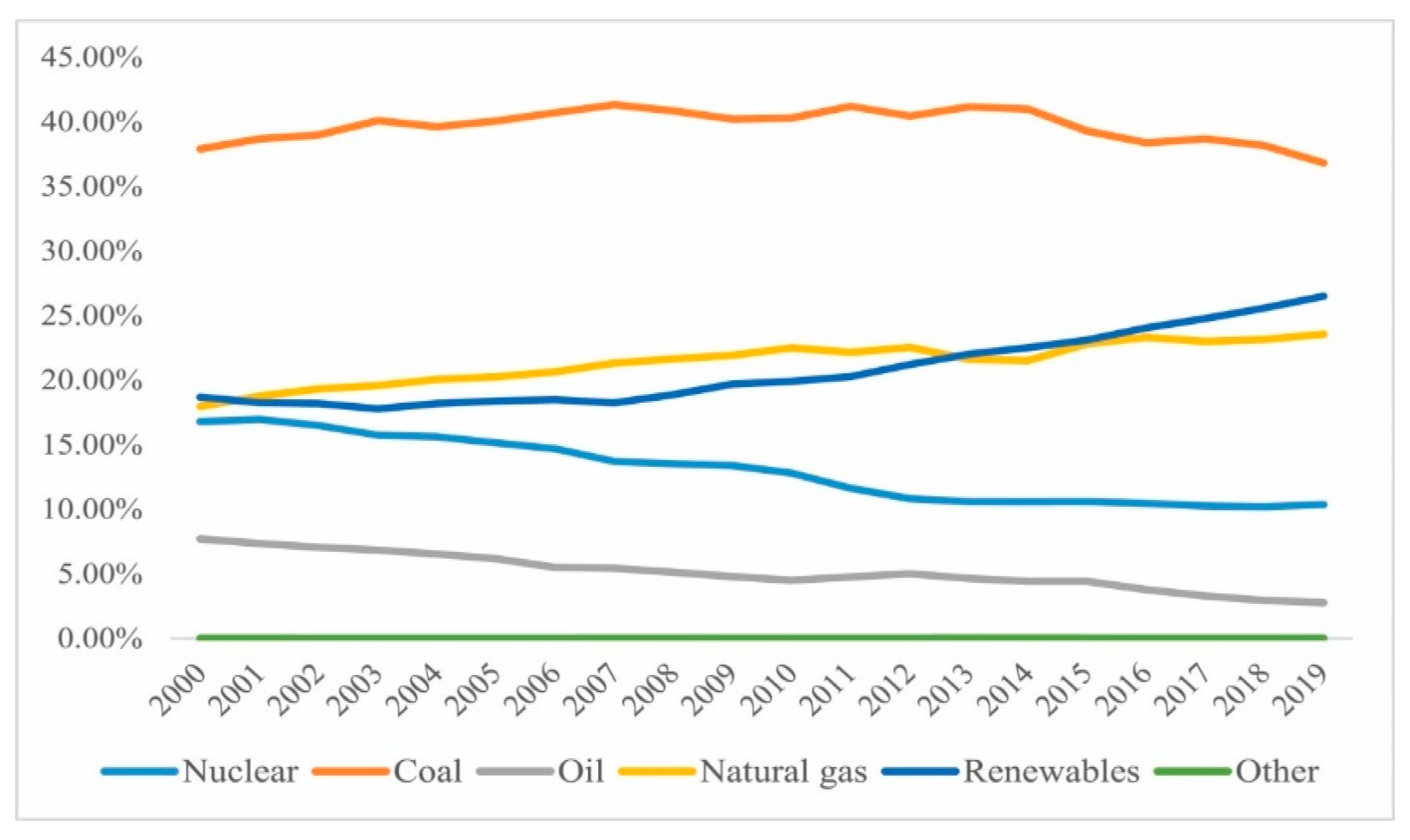
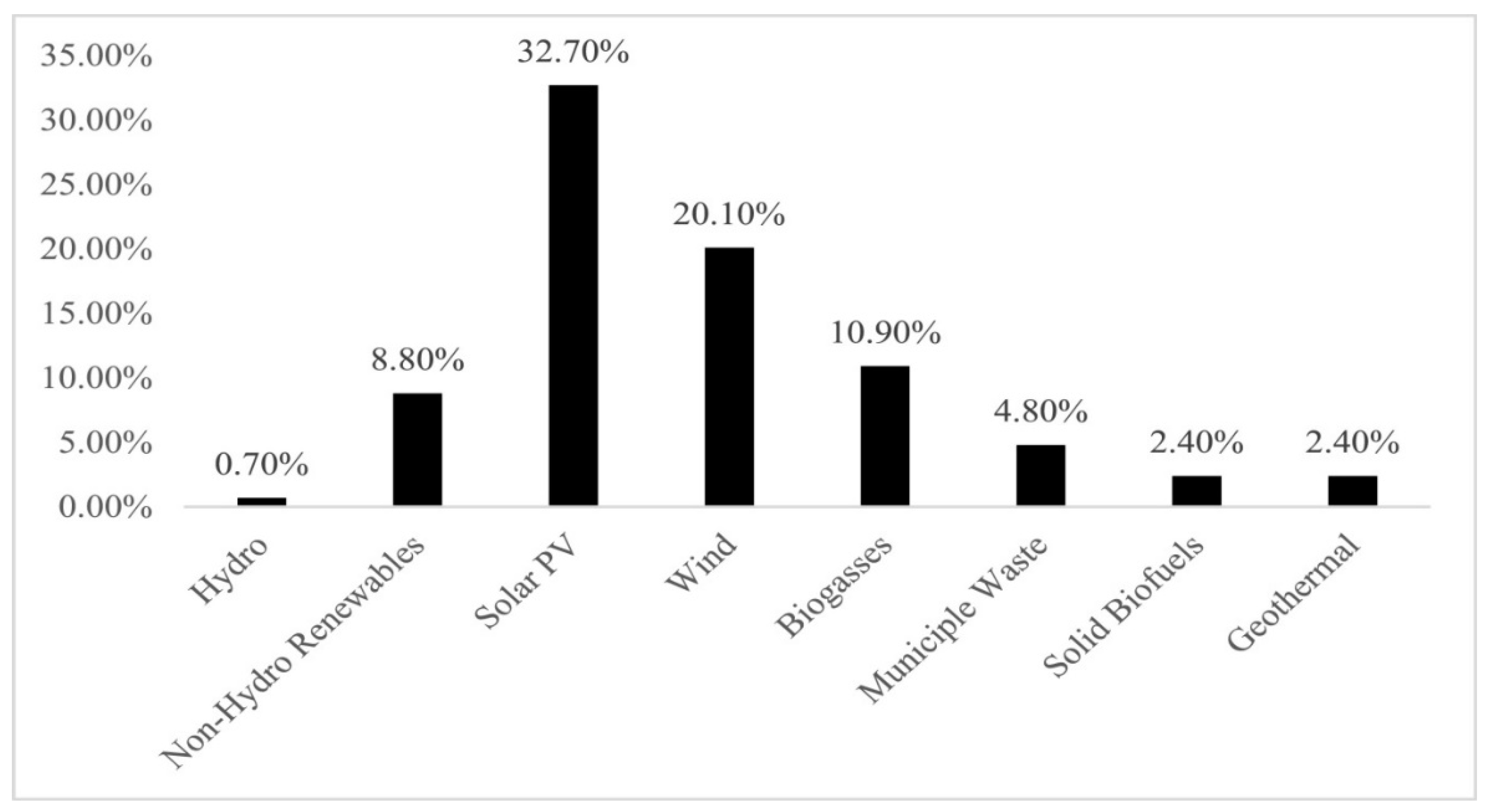
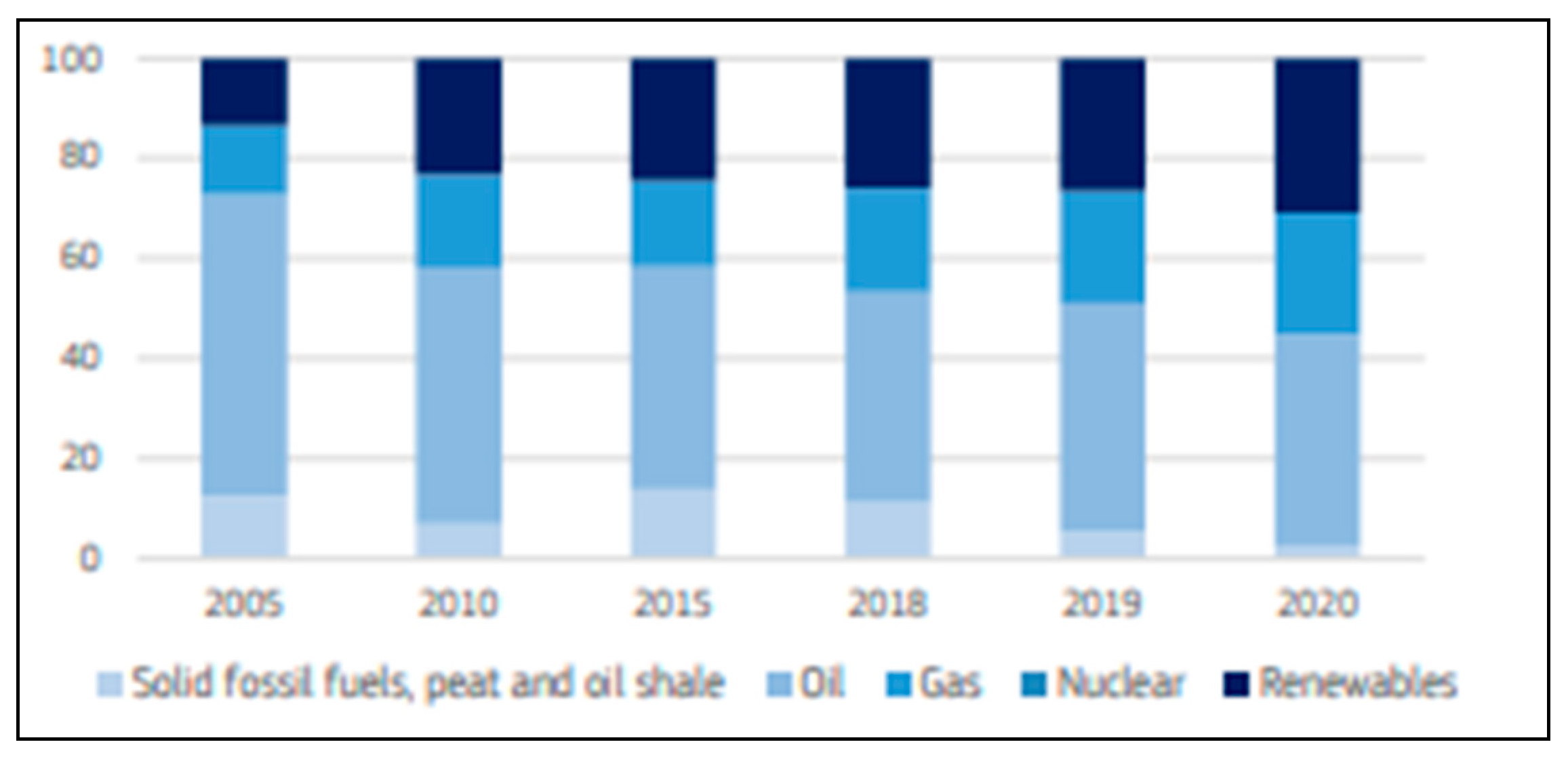
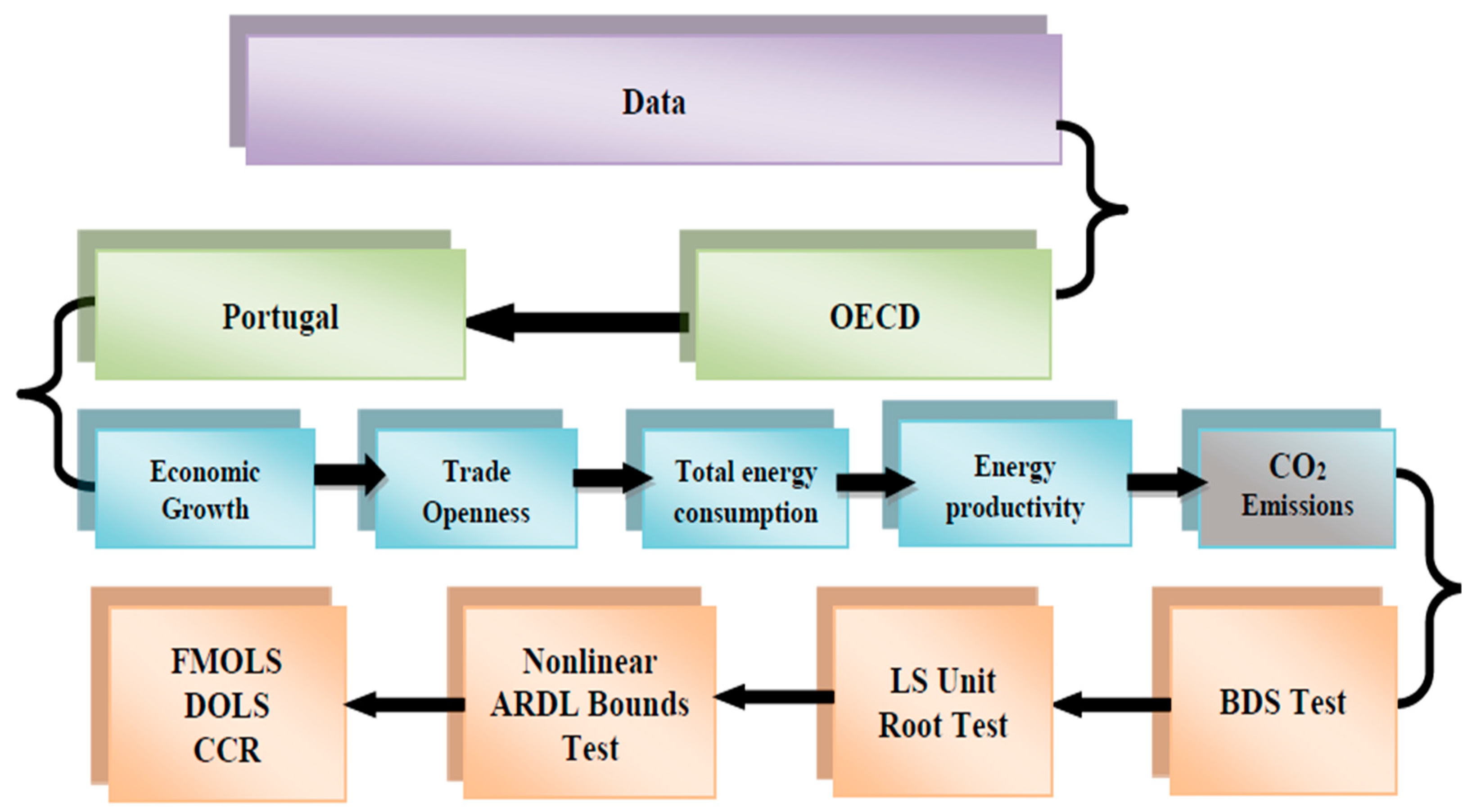
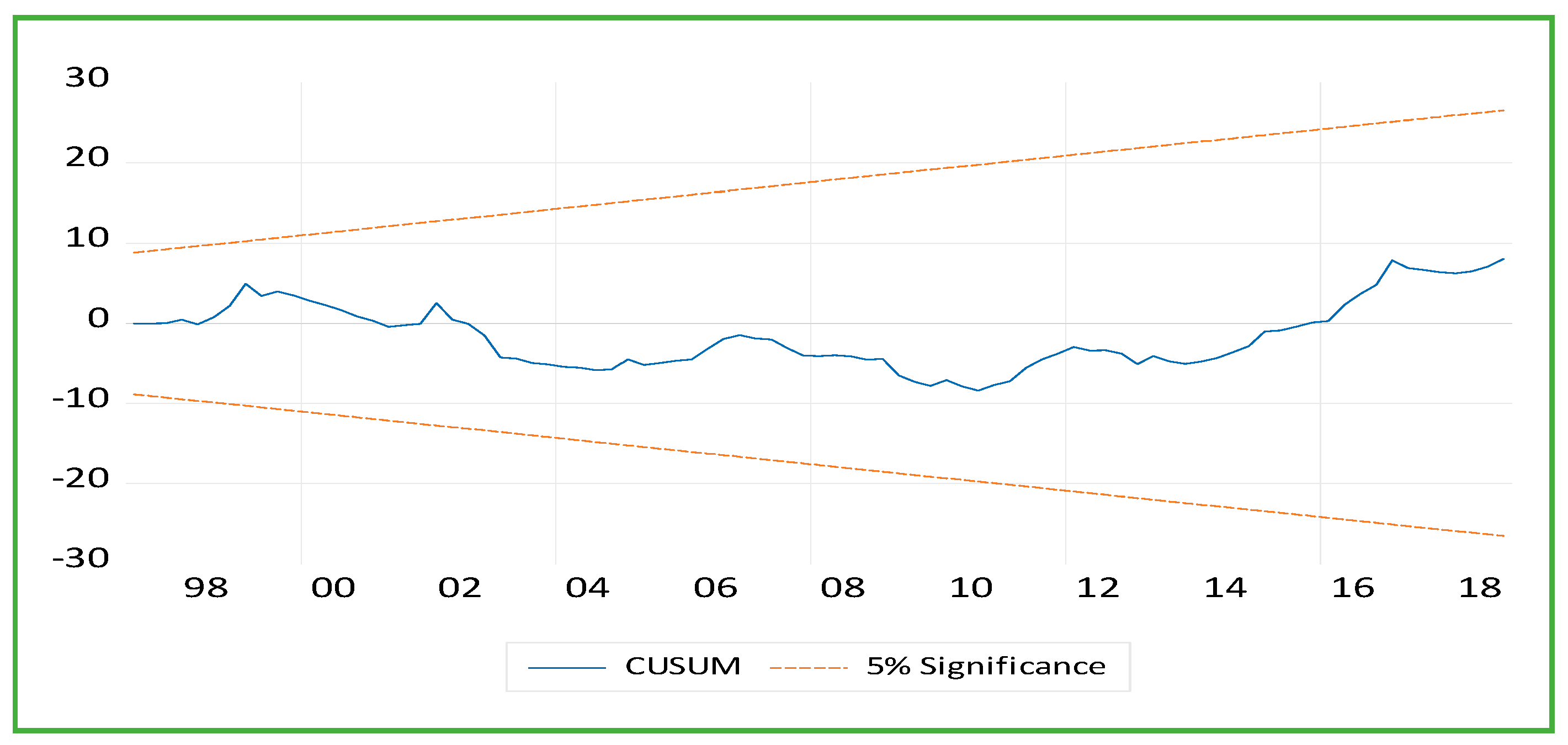
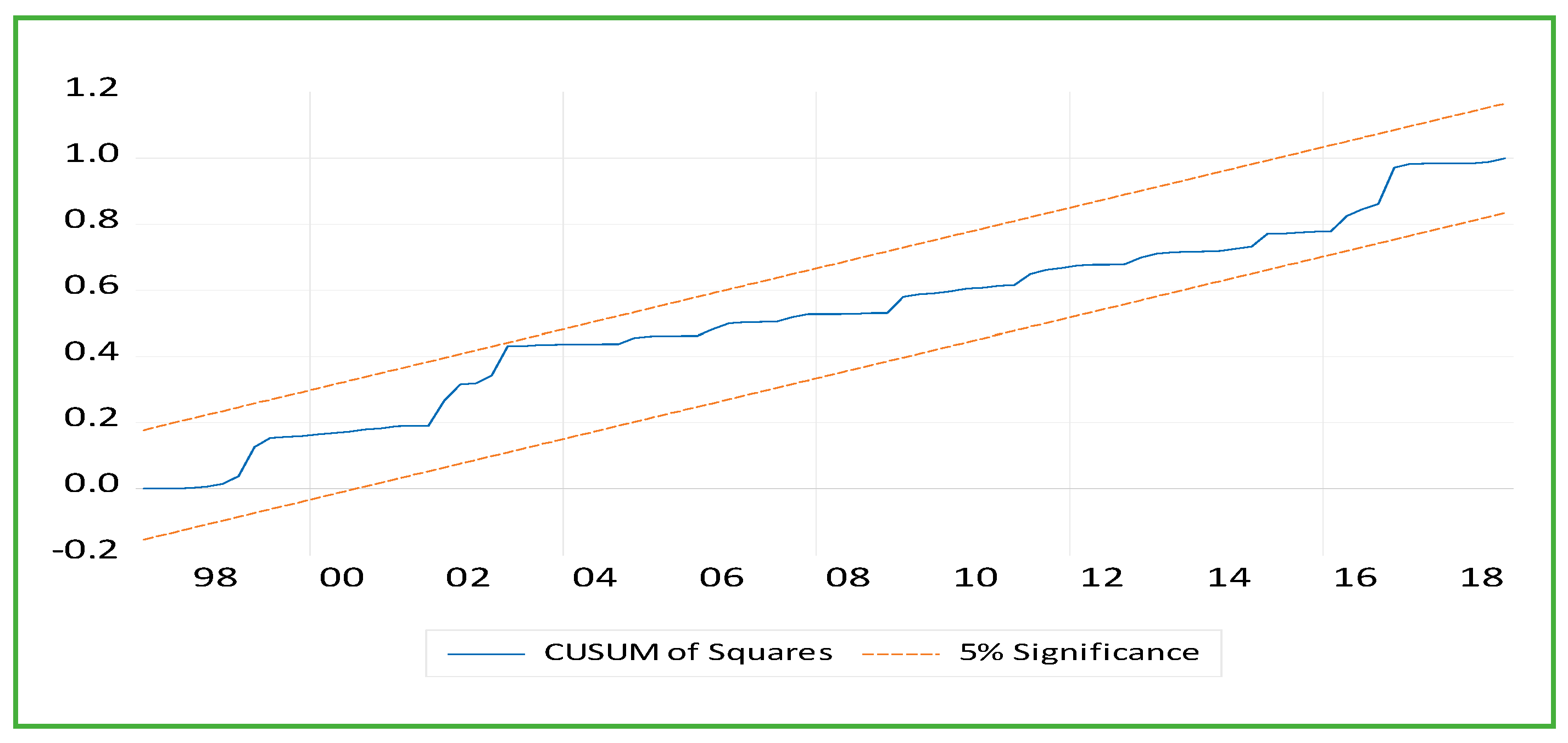
| Period 1990Q1–2019Q4 | Data Source OECD | ||||
|---|---|---|---|---|---|
| Code | LCO2 | LEP | LGDP | LTEC | LTRA |
| Mean | 4.722729 | 4.114320 | 22.66005 | 5.594359 | 10.80702 |
| Median | 4.707227 | 4.112219 | 22.70486 | 5.658330 | 10.83867 |
| Maximum | 4.819353 | 4.197604 | 22.79576 | 5.712535 | 11.05537 |
| Minimum | 4.611560 | 4.067508 | 22.42230 | 5.261382 | 10.52096 |
| Std. Dev. | 0.056407 | 0.030632 | 0.106331 | 0.132165 | 0.151277 |
| Skewness | 0.065400 | 0.284748 | −0.865774 | −1.236958 | −0.416283 |
| Kurtosis | 1.927575 | 2.114371 | 2.244457 | 3.071820 | 2.091481 |
| Jarque-Bera | 547.8366 | 477.2611 | 262.8565 | 648.9456 | 125.3614 |
| Probability | 0.365906 | 0.107908 | 1.300220 | 2.008769 | 2.631729 |
| At Level | ||||||
| LCO2 | LTEC | LGDP | LEP | LTRA | ||
| LS | t-Statistic (tau) | −3.997259 | −4.596786 | −5.873418 | −4.589023 | −5.007489 |
| Break Points | 2001Q4 2014Q3 | 1998Q3 2012Q3 | 1999Q1 2010Q4 | 1994Q1 2001Q3 | 1996Q4 2009Q3 | |
| Test critical values | 1% level | −6.107867 | −5.831440 | −5.810780 | −5.717540 | −5.016780 |
| 5% level | −5.495740 | −5.302100 | −5.396880 | −5.220447 | −6.311023 | |
| 10% level | −5.221680 | −4.970907 | −5.107240 | −4.961040 | −5.221680 | |
| At First Difference | ||||||
| LCO2 | LTEC | LGDP | LENG | LTRA | ||
| LS | t-Statistic (tau) | −6.096707 | −6.046787 | −6.18310 | −6.181579 | −6.895852 |
| Break Points | 1999Q1 2013Q3 | 1993Q3 2003Q4 | 1996Q1 2009Q4 | 1994Q3 2014Q4 | 2007Q3 2012Q4 | |
| Test critical | 1% level | −5.986360 | −6.022880 | −5.10131 | −5.824520 | −6.102211 |
| values | 5% level | −5.405120 | −5.380800 | −6.81102 | −5.297800 | −5.330001 |
| 10% level | −5.131760 | −5.039560 | −6.20106 | −4.966920 | −5.150602 | |
| LCO2 | ||||
| Dimension | BDSStatistic | Std. Error | z-Statistic | Prob. |
| 2 | 0.201424 | 0.003710 | 54.28873 | 0.0000 |
| 3 | 0.340019 | 0.005886 | 57.76742 | 0.0000 |
| 4 | 0.435383 | 0.006992 | 62.26777 | 0.0000 |
| 5 | 0.501646 | 0.007268 | 69.01935 | 0.0000 |
| 6 | 0.548595 | 0.006989 | 78.49039 | 0.0000 |
| LTRA | ||||
| Dimension | BDSStatistic | Std. Error | z-Statistic | Prob. |
| 2 | 0.194223 | 0.008235 | 23.58503 | 0.0000 |
| 3 | 0.328173 | 0.013159 | 24.93879 | 0.0000 |
| 4 | 0.419796 | 0.015758 | 26.64054 | 0.0000 |
| 5 | 0.480806 | 0.016517 | 29.10937 | 0.0000 |
| 6 | 0.521729 | 0.016020 | 32.56717 | 0.0000 |
| LGDP | ||||
| Dimension | BDSStatistic | Std. Error | z-Statistic | Prob. |
| 2 | 0.196699 | 0.004147 | 47.42921 | 0.0000 |
| 3 | 0.331343 | 0.006612 | 50.11263 | 0.0000 |
| 4 | 0.424008 | 0.007894 | 53.71174 | 0.0000 |
| 5 | 0.488331 | 0.008247 | 59.20983 | 0.0000 |
| 6 | 0.534142 | 0.007971 | 67.00743 | 0.0000 |
| LTEC | ||||
| Dimension | BDSStatistic | Std. Error | z-Statistic | Prob. |
| 2 | 0.197245 | 0.004209 | 46.86240 | 0.0000 |
| 3 | 0.332030 | 0.006673 | 49.75613 | 0.0000 |
| 4 | 0.423148 | 0.007923 | 53.40840 | 0.0000 |
| 5 | 0.485615 | 0.008231 | 58.99495 | 0.0000 |
| 6 | 0.529287 | 0.007912 | 66.89886 | 0.0000 |
| LEP | ||||
| Dimension | BDSStatistic | Std. Error | z-Statistic | Prob. |
| 2 | 0.182855 | 0.006110 | 29.92911 | 0.0000 |
| 3 | 0.301211 | 0.009720 | 30.98992 | 0.0000 |
| 4 | 0.377275 | 0.011583 | 32.57035 | 0.0000 |
| 5 | 0.424733 | 0.012082 | 35.15554 | 0.0000 |
| 6 | 0.454065 | 0.011659 | 38.94666 | 0.0000 |
| Nonlinear-ARDL Long Run Form | ||||
|---|---|---|---|---|
| Variable | Coefficient | Std. Error | t-Statistic | Prob. |
| LEP_POS | −3.247606 | 0.444983 | −7.298266 | 0.0000 |
| LEP_NEG | −0.987401 | 0.526886 | −1.874032 | 0.0642 |
| LGDP_POS | 0.291129 | 0.218241 | 1.333976 | 0.1857 |
| LGDP_NEG | 1.987156 | 0.905697 | 2.194064 | 0.0309 |
| LTEC_POS | 0.034088 | 0.130601 | 0.261006 | 0.7947 |
| LTEC_NEG | −0.856066 | 0.315882 | −2.710082 | 0.0081 |
| LTRA_POS | 0.717775 | 0.263122 | 2.727915 | 0.0077 |
| LTRA_NEG | −0.166010 | 0.442954 | −0.374778 | 0.7087 |
| C | 4.705552 | 0.016182 | 290.7852 | 0.0000 |
| CointEq(−1) * | −0.085673 | 0.015447 | −5.546284 | 0.0000 |
| Bounds Test | ||||
| F-Bounds Test | Null Hypothesis: No levels relationship | |||
| Test Statistic | Value | Signif. | I(0) | I(1) |
| Asymptotic: n = 1000 | ||||
| F-statistic | 4.790713 | 10% | 1.85 | 2.85 |
| k | 8 | 5% | 2.11 | 3.15 |
| 2.5% | 2.33 | 3.42 | ||
| 1% | 2.62 | 3.77 | ||
| DOLS | ||||
|---|---|---|---|---|
| Variable | Coefficient | Std. Error | t-Statistic | Prob. |
| LEP | −1.686552 | 0.206541 | −8.165718 | 0.0000 |
| LGDP | 0.479874 | 0.119618 | 4.011733 | 0.0001 |
| LTEC | 0.168668 | 0.091955 | 1.834231 | 0.0694 |
| LTRA | 0.075381 | 0.101528 | 0.742464 | 0.4594 |
| C | 0.916453 | 2.210384 | 0.414613 | 0.6793 |
| CCR | ||||
| Variable | Coefficient | Std. Error | t-Statistic | Prob. |
| LEP | −1.415517 | 0.208118 | −6.801508 | 0.0000 |
| LGDP | 0.548103 | 0.105657 | 5.187572 | 0.0000 |
| LTEC | 0.138002 | 0.096118 | 1.435750 | 0.1539 |
| LTRA | 0.002670 | 0.097200 | 0.027466 | 0.9781 |
| C | −1.127766 | 1.933655 | −0.583230 | 0.5609 |
| FMOLS | ||||
| Variable | Coefficient | Std. Error | t-Statistic | Prob. |
| LEP | −1.430251 | 0.206846 | −6.914557 | 0.0000 |
| LGDP | 0.560931 | 0.107820 | 5.202475 | 0.0000 |
| LTEC | 0.145480 | 0.090975 | 1.599115 | 0.1127 |
| LTRA | −0.003066 | 0.102599 | −0.029886 | 0.9762 |
| C | −1.253479 | 1.973398 | −0.635188 | 0.5266 |
| F-statistic | 0.956442 | Prob. F(2.86) | 0.3883 |
| Obs* R-squared | 2.458752 | Prob. Chi-Square(2) | 0.2925 |
Disclaimer/Publisher’s Note: The statements, opinions and data contained in all publications are solely those of the individual author(s) and contributor(s) and not of MDPI and/or the editor(s). MDPI and/or the editor(s) disclaim responsibility for any injury to people or property resulting from any ideas, methods, instructions or products referred to in the content. |
© 2023 by the authors. Licensee MDPI, Basel, Switzerland. This article is an open access article distributed under the terms and conditions of the Creative Commons Attribution (CC BY) license (https://creativecommons.org/licenses/by/4.0/).
Share and Cite
Sowah, J.K., Jr.; Genc, S.Y.; Castanho, R.A.; Couto, G.; Altuntas, M.; Kirikkaleli, D. The Asymmetric and Symmetric Effect of Energy Productivity on Environmental Quality in the Era of Industry 4.0: Empirical Evidence from Portugal. Sustainability 2023, 15, 4096. https://doi.org/10.3390/su15054096
Sowah JK Jr., Genc SY, Castanho RA, Couto G, Altuntas M, Kirikkaleli D. The Asymmetric and Symmetric Effect of Energy Productivity on Environmental Quality in the Era of Industry 4.0: Empirical Evidence from Portugal. Sustainability. 2023; 15(5):4096. https://doi.org/10.3390/su15054096
Chicago/Turabian StyleSowah, James Karmoh, Jr., Sema Yilmaz Genc, Rui Alexandre Castanho, Gualter Couto, Mehmet Altuntas, and Dervis Kirikkaleli. 2023. "The Asymmetric and Symmetric Effect of Energy Productivity on Environmental Quality in the Era of Industry 4.0: Empirical Evidence from Portugal" Sustainability 15, no. 5: 4096. https://doi.org/10.3390/su15054096
APA StyleSowah, J. K., Jr., Genc, S. Y., Castanho, R. A., Couto, G., Altuntas, M., & Kirikkaleli, D. (2023). The Asymmetric and Symmetric Effect of Energy Productivity on Environmental Quality in the Era of Industry 4.0: Empirical Evidence from Portugal. Sustainability, 15(5), 4096. https://doi.org/10.3390/su15054096









